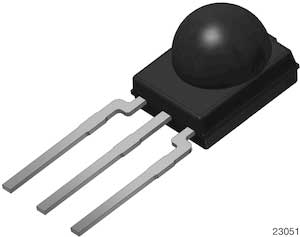
MALVERN, Pa. — Sept. 30, 2019 — Vishay Intertechnology, Inc. (NYSE: VSH) today introduced a new series of infrared (IR) sensor modules in five compact package types. Featuring a fast 300 μs reaction time, Vishay Semiconductors TSSP9xxx AGC 0 devices deliver long range presence and proximity sensing up to 2 m, and a range up to 30 m for light curtain and perimeter guard applications.
Compared with previous-generation devices, the fixed-gain sensors released today provide higher interference strength without spurious signals and an output pulse width closer to the optical burst length. In addition, they offer an almost constant detection threshold over their -25 °C to +85 °C temperature range and can detect a valid IR signal up to a higher DC illuminance level.
The TSSP9xxx AGC 0 is a good choice for fast proximity applications (~15 ms) by using a burst pattern with variable intensity. The devices are ideal for sensing the distance to objects for toys, drones, robots, and vicinity switches. They may also be used as reflective sensors for hand dryers, towel or soap dispensers, water faucets, toilets, vending machine fall detection, and security and pet gates. To simplify designs in these applications, TSSP9xxx series devices feature a PIN photodiode and sensor IC in compact Minimold (TSSP930..), Mold (TSSP940..), Heimdall (TSSP950..), Panhead (TSSP960..), and Minicast (TSSP980..) packages.
The modules operate at a supply voltage range from 2.0 V to 3.6 V, feature a low supply current of 0.8 mA, and offer carrier frequencies of 38 kHz and 56 kHz. The sensors are designed to receive IR pulses from an emitter with a peak wavelength of 940 nm. The devices are insensitive to supply voltage and ripple noise and provide shielding against EMI, while an IR filter suppresses visible light. The TSSP9xxx series is RoHS-compliant, halogen-free, and Vishay Green.
Samples and production quantities of the new sensors are available now, with lead times of four weeks.